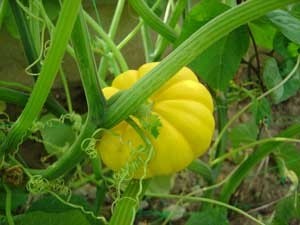

| Botanical Name: |
| Cucurbitaceae Family |
| Description: |
| Most vine crops, including cucumbers, squash, melons, gourds and pumpkins, are members of the squash family. And although each of these different vegetables come in many different varieties in and of themselves, most members of this family have the same growing requirements for successful production. |
| Planting Time: |
| Seeds and transplants should be started when the soil temperature reaches 60ºF and all danger of frost has passed. |
| Exposure: |
| full sun |
| Soil: |
| well-drained, nutrient-rich soil with a slightly acidic pH |
| Planting: |
| Vine crops do not transplant well so start with disease resistant plants or sow seeds directly outdoors. Prepare mounds of raised soil 1 to 2 feet in diameter, spaced 3 to 5 feet apart to provide room for vines to run. Plant seeds evenly around the mounds, eventually letting the hardiest of the seedlings take over.
Most vegetables in this family also come in varieties cultivated especially for container gardening. Look for diseases resistant plants or seeds with the words 'patio' or 'bush' variety. |
| Watering: |
| Soil should be kept evenly moist (not wet). Give plants an inch of water per week during dry weather. Avoid wetting leaves directly to prevent disease. |
| Maintenance: |
| Some members of this family may require a trellis or other support for climbing and will required more water than those left to grow along the ground. Support heavy fruit with a coffee can or plastic container to keep it off the ground and prevent it from rotting or developing a flat spot on one side.
Side dress vines with compost tea when they begin to flower. Squash flowers may need to be covered and then pollinated by hand to prevent cross breeding among different cultivars or nearby gardens. |
| Harvesting & Storage: |
| Harvesting and storage of vine crops will depend on the variety grown. For example some squash are better picked before maturing, pumpkins may be harvested at a desired size and cucumbers and zucchini should be picked often to keep plants productive. |
| Diseases and Pests: |
| The most common afflictions to members of the squash family come by way of three insect pests: the cucumber beetle, the squash vine borer and the squash bug. The cucumber beetle is the most problematic because it damages germinating seeds and spreads bacterial wild and cucumber mosaic virus. Planting pansies, marigolds, radishes and catnip can all help to repel this pest ( and the squash bug and squash vine borer), along with spraying a solution of equal parts wood ash and dehydrated lime on the plants.
To "foil" the squash vine borer, which usually strikes in July, wrap the bases of vines with old panty hose or tin foil or sprinkle around the stems with black pepper. (Planting radishes and spraying a wood ash/lime solution will also help). The best defense against the squash bug is to keep the garden free of dead plant debris where they can hide and multiply, and training plants to grow up off the ground on fences or trellises. Lay boards down on the soil around the plants. Bugs will hide under them. Lift up the boards in the early morning and eliminate the bugs. |
| Tips to Success: |
| Squash and corn are probably the most famous duo in the vegetable world. They make great companion plants. The squash shades out weeds and deters raccoons from raiding corn with its big, prickly leaves. In turn, the tall corn shades the squash during the day and provides the vines with support to climb skyward. |
About The Author: Ellen Brown is an environmental writer and photographer and the owner of Sustainable Media, an environmental media company that specializes in helping businesses and organizations promote eco-friendly products and services. Contact her on the web at http://www.sustainable-media.com
Add your voice! Click below to comment. ThriftyFun is powered by your wisdom!
I remember planting a tasty plum one year only to have a wonderful tree to bloom and grow but never produce. Does it need another tree, special fertilizer,more sun, to blossom and fruit? Also, my self-pollinating Southern Apple tree has only a dozen, though delightful, apples each year, after seven years. Is there anything I can do to increase the production? There is little to no sign of disease or pests and I water deep weekly, but am stumped.
I have good new growth from spraying Liq. Sea Kelp
but no blossoms in my organic yard.
Add your voice! Click below to comment. ThriftyFun is powered by your wisdom!